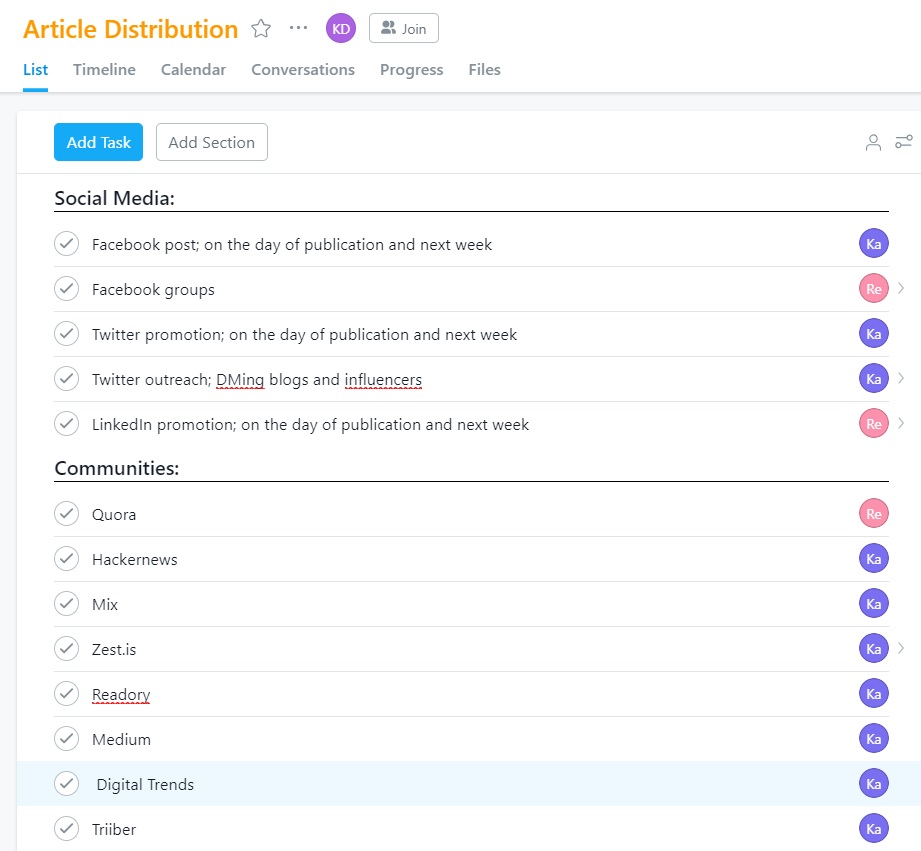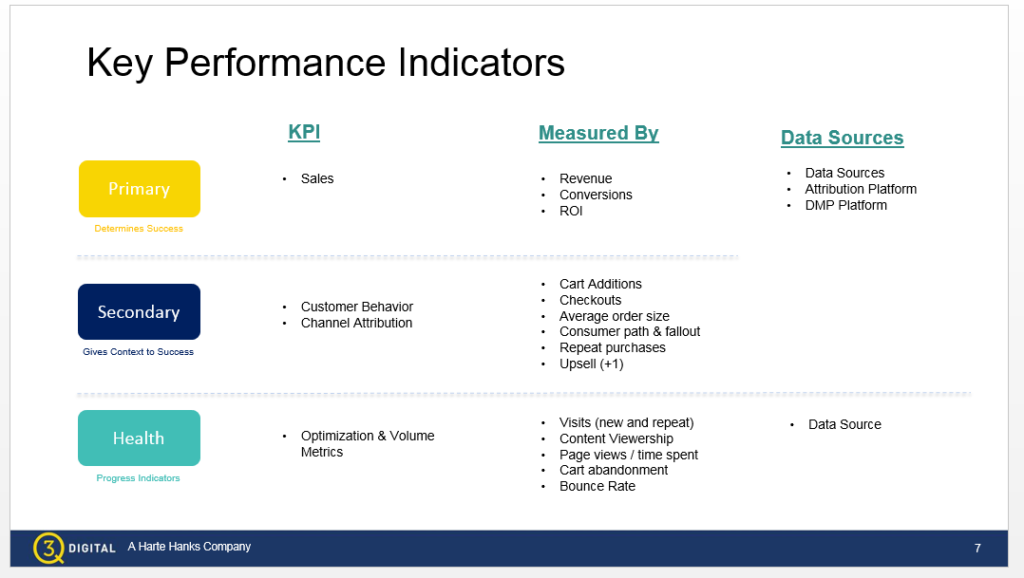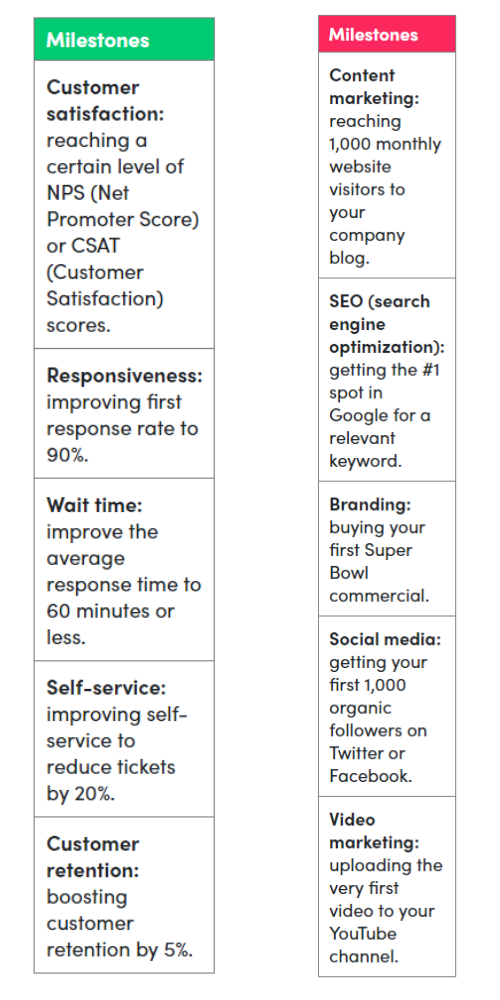Consistency is the cornerstone of good marketing. You only have to look at top brands to see this in action: Apple’s sleekness, Coca-Cola’s playfulness, Disney’s magic.
Consistency is equally critical for startups. Stacked Marketer turned a free newsletter into a six-figure revenue generator by staying actionable, convenient, and entertaining.
Being consistent earns trust and cements brand status—qualities that add 10–20% to your overall growth, according to LucidPress research. On the flip side, inconsistency confuses consumers, limiting your chance to generate leads.
A marketing playbook helps you achieve brand consistency across channels and campaigns.
In this article, we’ll explain how to create a marketing playbook to align your teams and boost your sales opportunities.
Table of contents
- A marketing playbook gets everyone on the same page
- Five components of a successful marketing playbook
- How to create a marketing playbook
- 1. Lay out the key challenges and expected results
- 2. Build consistency with clear audiences
- 3. Establish which content assets will engage customers
- 4. Summarize marketing communication guidelines to set the right tone
- 5. Align teams with clear roles and responsibilities
- 6. Map out key dates to keep your project on track
- 8. Define how success is measured
- Use marketing playbooks as a tool for learning
- Conclusion
A marketing playbook gets everyone on the same page
A marketing playbook is a reference guide that outlines how a business will manage its marketing on a particular channel or campaign.
It’s a concept borrowed from American football, where a coach has a folder of plays to defeat the opposition in different situations.
In the coach’s playbook, every player knows their role and what they must do to make the play work. This helps players achieve objectives consistently, even when team members change.
Marketing playbooks work the same. They map out a repeatable process to avoid chaos and confusion in your team and with customers.
Take Visme’s guide to asymmetrical balance. Here’s how the guide is promoted on Twitter:
The informative, conversational tone and fun imagery are the same as the post on the Visme website:

And the same vibe as the video embedded in the guide:
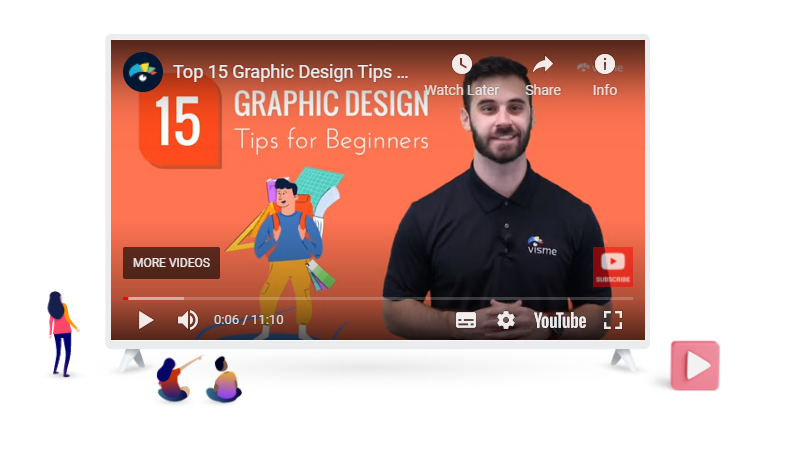
Visme maintains consistency throughout the customer journey. This tells us its social media team, blog content writers, website copywriters, and everyone else, are aligned on their task execution.
This consistency creates familiarity, breeding trust that turns prospects into customers and customers into advocates.
If a social media follower clicks through a casual post to see a formal sales piece, their experience changes, as does their impression of Visme as a brand.
So, how can marketers align every department for a consistent customer experience?
Top marketers are 414% more likely to report success when they document their strategy, according to CoSchedule’s 2022 Trend Report. A playbook does exactly this.
It also helps you:
- Create the right type of content;
- Reach the right target audience on the right channels;
- Produce content faster;
- Cut down on wasted time and spend;
- Quickly onboard new team members;
- Incrementally improve marketing by learning from each campaign.
A good playbook keeps you organized, which, according to CoSchedule, increases the likelihood of successful digital marketing initiatives almost sevenfold.
It’s important to note at this stage that “playbook” is a popular word in marketing. You can find playbooks on every type of tactic you can think of. These are essentially guides on how to do things.
FedEx’s “E-commerce Playbook,” for example, is a useful resource for building a successful ecommerce brand aimed at ecommerce business owners.
A marketing playbook, in the traditional sense, is an internal document. Like the plays of an NFL team, its contents lay out how you win.
Five components of a successful marketing playbook
The purpose of a marketing playbook is to arm your team with the knowledge to do their job to the best of their ability. It does this by connecting strategy and creative.
What’s inside will differ depending on the channel or marketing campaign.
For example, if your goal is to raise brand awareness using videos, your content, channels, and key performance indicators (KPIs) will be different from a campaign for generating revenue through strategic partnerships.
Generally speaking, each playbook should have five main parts.
1. Marketing strategy
Strategy is necessary for broader playbooks, like a social media playbook. The more specific you get (e.g., a Twitter threads playbook), the less likely you’ll need to include all of your high-level goals.
Marketing strategy should detail:
- Goals and objectives. What you want the playbook to help you achieve.
- Positioning. Where your product or service fits into the market.
- Target audience. Your customer profiles and buyer personas.
- Marketing funnel. Where the campaign fits into your wider marketing and the customer journey (e.g., top-of-the-funnel for raising awareness or button-of-the-funnel for driving sales).
- Content channels. Where you’ll engage audiences.
Leading with strategy clarifies why the playbook is required and the short- or long-term benefit of the channel or campaign.
It’s also subject to change. Goals, position, and personas can all be tweaked based on what you learn from the success (or failure) of a campaign. Treat your playbook as a living document rather than something set in stone.
2. Content creation
The content creation section covers the type of content required, who’s creating it, the process, and how you expect assets to look and sound.
It explains the assets needed based on goals. For example, if your goal is to generate leads, assets might be webinars, landing pages, and emails. If the goal is to raise awareness, they might be social media content and blog posts.
Each person in the content team will refer to this section to find out their role and responsibilities in the overall workflow.
This section should also feature your brand guidelines. Users should be clear on tone of voice, fonts, colors, and etiquette for each channel.
Zendesk’s playbook clearly explains how to tailor its messaging to different audiences.
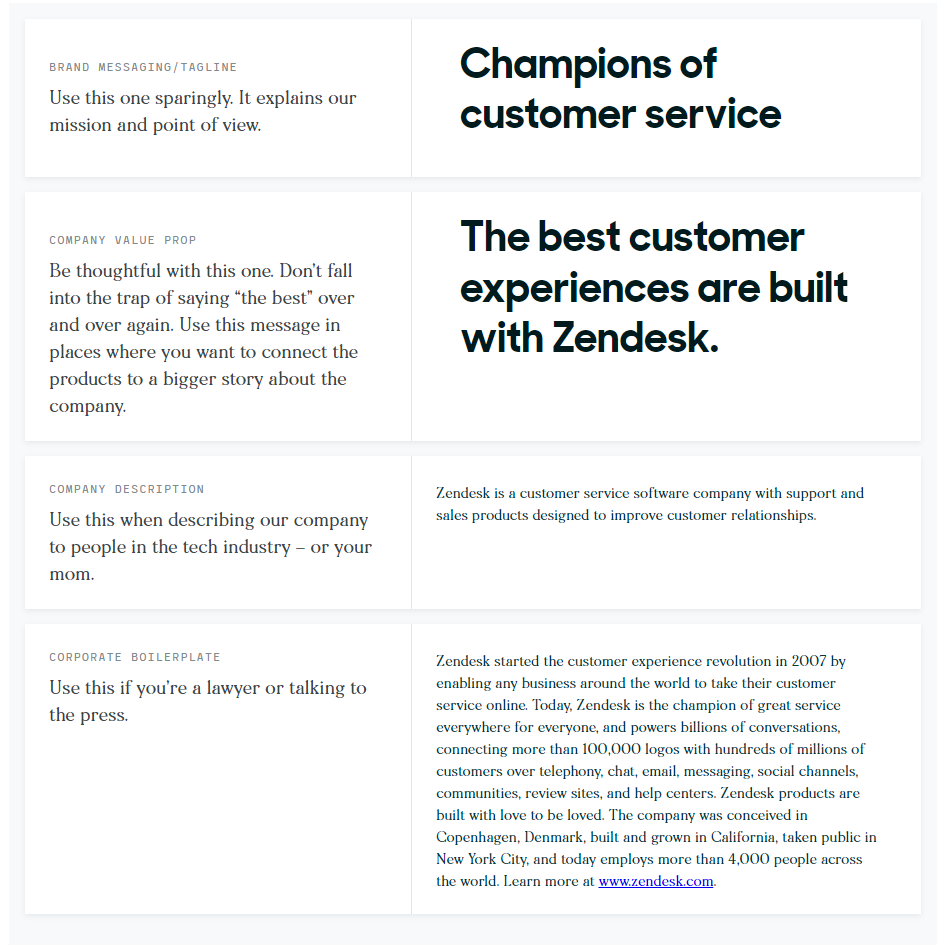
Zendesk offers tech industry people a concise description of how Zendesk can benefit their company.
The press might be looking for more details about Zendesk so they can accurately report on the tool. They are given a longer description, adding context and detailing the company’s history.
Teams are clear on what to do, so audiences get what they need.
3. Promotion channels
This playbook chapter lists everywhere content will be shared, how to share it, and how often. Depending on which channels you use in your marketing, this might include:
- Newsletters;
- Blog posts;
- Company social media channels;
- Personal social media accounts;
- Influencers;
- Company and industry podcasts;
- YouTube;
- Paid ads (Google and social media);
- Messaging apps;
- Syndication platforms.
Users should easily understand which assets are promoted on which channels and the distribution schedule.
For example, let’s say for every new feature launch, you create a new landing page. To drive traffic, promotion might look something like this:
- Deliver content to two industry influencers two weeks before launch;
- Talk about it on a company podcast one week before launch;
- Publish blog post on launch day;
- Schedule six posts on Twitter in first week of launch;
- Schedule eight posts on Instagram in first week of launch;
- Share once on personal team accounts one week after launch;
- Answer questions on Reddit and Quora in first two weeks of launch;
- Run a four-week-long ad on Facebook.
Base your promotion plan on successful past launches and highly engaged channels.
Here’s an example of how Nightwatch uses Asana to organize distribution:
The color-coded initials in the right-hand column correspond to different members of the marketing team, so everyone knows their role.
Creating distribution checklists in your marketing playbook feeds into content creation, ensuring each new piece of content gets lift.
4. Measurement
This chapter of the marketing playbook covers how you’ll track the success of each campaign, channel, or asset.
It should include primary and secondary KPIs and metrics related to marketing goals, as well as the platforms (e.g., Google Analytics and CRM) used to track them.
This example from 3Q Digital shows which KPIs are tracked and how:
This section will typically be tied to a wider marketing measurement plan and used to inform strategy and implementation decisions. It also helps to align processes and keep teams accountable for performance.
If specific elements of your content assets are tested after launch, these will also be detailed here. For example, email subject lines, type of social proof, image placement, and call to actions.
When teams know what to track and how metrics relate to the overall objective, they can transform data into actionable insights to improve the play.
5. Execution
The final chapter acts both as a summary of previous chapters and a guide for the marketing team moving forward. It should include:
- Key date calendar. A content creation timeline and key milestones based on targets.
- Usage policies. The do’s and don’ts of each platform, including details of the channel manager and project manager.
- Marketing software. Any marketing automation, social media, analytics, and performance tools you use.
- Automated replies. Standard email reply and social media message templates that can be used for out-of-hours customer service and engagement.
- Evaluation reports. Monthly, quarterly, or annual templates for individual and campaign reporting. Individual reports should cover a specific channel. For example, for Twitter, a social media manager will generate engagement reports, whereas a content marketing manager will look at click-through rate and conversion rate. Campaign reports will cover results such as sales figures, leads generated, and cross-channel engagement for the period.
How to create a marketing playbook
Few people will read your marketing playbook word for word. Instead, they’ll pick out parts that are relevant to them.
NN Group’s most recent eye-tracking study found that people still love to skim online. Depending on the motivation, people will collect information in different skimming patterns.
A copywriter looking to see how to write email subject lines for holiday campaigns will likely look at headings, searching for the most relevant information to their task.
As Maryanne Wolf notes in the Guardian, skim reading is the new normal:
“Many readers now use an F or Z pattern when reading in which they sample the first line and then word-spot through the rest of the text.”
Skim-reading is an incredibly efficient way to absorb relevant information. Design your playbooks so they’re easy to skim, and at all costs, avoid density in the writing and formatting.
Here are some tips to make your playbook usable as a quick reference tool:
- Format text left to right;
- Keep sentences concise;
- Keep paragraphs to no longer than three sentences with white space in between;
- Bold keywords and key messages to attract the eye;
- Use highlight boxes to call out critical information;
- Break up text with actionable headings and subheadings that clearly label what the section is about;
- Use images to add context;
- Cut anything irrelevant;
- Include a table of contents so people can easily locate information (if it’s digital, hyperlink it so users can jump quickly to sections).
Think about your playbook from the perspective of a new hire. What information do they need to execute a task immediately?
Here are eight tips for creating and curating your playbook.
1. Lay out the key challenges and expected results
In a business plan, key questions are answered in an executive summary. The answers inform investors so they can understand what they’ll learn and decide whether to read the rest of the plan.
In a marketing playbook, these are critical questions like:
- Why is this playbook necessary?
- Who are you, why do you exist, what makes you special?
- What is the purpose of the channel or campaign, and why does it matter?
Your playbook doesn’t have to be as formal as a business plan, but it’s worth approaching the introduction in a similar way.
Write an overview that includes the following:
- Mission statement. Your core values and central purpose.
- Company information. Your products or services, pricing, and details of owners and managers.
- Business highlights. How you got to where you are now. How market share and revenue have grown.
- Target market. Your audience and competitors.
- Key goals and challenges. What you’re looking to achieve and the expected results.
- Opportunities. What the rewards of successful plays are.
- Key phases. Expected launch dates and milestones.
Finish with a final paragraph that tells readers what they’ll get from the document and how it benefits their work.
The intro to IAB’s account-based marketing playbook, for example, makes the benefits of the playbook and ABM clear:

Tell readers what they’ll learn and what that information can help them achieve and you’re more likely to get their buy-in.
2. Build consistency with clear audiences
For marketing to work, it has to reach the right people. If you’re at the point of creating a content marketing playbook, you’re likely clear on who your target audience is.
List your buyer personas to help readers understand who they’re talking to. In its playbook, organic snack maker LivBar gives its persona a specific identity:
Buyer personas should be created based on data, not guesses. The goal of including personas in your marketing playbook is to help them relate to realistic prospects who are likely to buy your product. It’s much more effective for marketers to speak to real pain points past customers have reported.
As well as your core audience, list secondary and fringe audiences. These are the people who you’re not targeting with your primary messaging, but who the message still impacts.
For example, let’s say you sell accounting software to law firms. Your primary audience is the Chief Technology Officer (CTO) who has the spending power to buy your product.
Though your marketing is aimed at the CTO, an accountant who shares the same interests might see your ad. While they have no power to make the purchase, they’re ultimately the ones using it. The accountant tells the CTO about your great product, who then green lights the purchase. The accountant is a secondary audience who can influence sales.
Fringe audiences act in a similar indirect way. This could, for instance, be an admin assistant or receptionist who shares a common interest with the accountant or CTO. They might not see the ad on LinkedIn where your primary audience is, but they might stumble across your Twitter account and bring up your software in conversation.
Providing this extra information will help marketers understand the bigger picture and craft the right message for the channel.
3. Establish which content assets will engage customers
What is the ultimate goal for your campaign or channel? Answering this question will help readers understand why they should use certain assets. It will also give them something to work towards—92% of marketers who have a goal are successful in achieving it.
Use the SMART framework to set realistic goals. Make the objective clear by writing it as a statement.
Here’s an example framework to follow:
By [date], the [team] will reach [number] [metric] every [time frame].
Let’s flesh that out:
“By May 31st, the content marketing team will reach 100 MQLs every month.”
Or for a specific channel:
“By Q4, the content marketing team will reach 500 new YouTube subscribers every month.”
Follow this with the content assets you’ll be using to achieve it. For each channel, include where it fits into the customer journey, what its purpose is, and where it’s shared. This will help marketers understand its purpose.
For example:
| Content asset | Customer journey stage | Goal | Distribution channel |
| Blog post | Awareness, consideration | Answer a commonly asked question, promote product | Website, Medium, LinkedIn |
| Explainer video | Consideration | Contribute to an existing conversation | YouTube, Facebook |
| White paper | Decision | Promote a product | Press release, industry publication |
Don’t get bogged down in the details of how to create each asset here. Link to additional playbooks or guides where that information can be found.
Focus on the “what” and “why.” This, combined with buyer personas and brand guidelines, will give marketers the need-to-know information to maintain consistency.
4. Summarize marketing communication guidelines to set the right tone
Brand guidelines are the glue that holds everything together. They ensure the customer experience on Instagram is consistent with the experience on your website.
If your brand has a style guide, link to it in your playbook and summarize key information. Focus on design and copy rules. Give marketers what they need to do the work, such as:
- Logo requirements. Approved sizes and placements.
- Color palette. Brand color, functional colors, background colors, and accent colors.
- Editorial style guide. Words marketers can and can’t use, topics they can and can’t talk about, and other companies they can and can’t mention.
- Typography. Preferred typeface and fonts, kerning, tracking, leading, and visual hierarchy.
Elements from your guidelines like mission statement, vision, values, and personality can be left for the intro.
Use images and screenshots from existing assets to show guidelines in practice and include any templates related to content assets (e.g., newsletter templates and automated replies), but encourage readers to refer to the full style guide for specifics.
5. Align teams with clear roles and responsibilities
A winning play relies on every team member knowing their role and working together to execute it.
An editor needs a draft from a content writer, who needs a brief from a content marketing manager, which is based on information from a content strategist. If any link in that chain is broken, content doesn’t hit the mark.
Getting teams pulling in the same direction can have a big payoff. On average, aligned companies have 19% faster growth and profits 15% higher than non-aligned competitors.
Define your content workflow so that everyone knows what’s expected of them.
Identify who is involved in the project and what their tasks are. For each task, explain what’s required. This will help cut down on edits and redundant steps.
For example, if the task is to create images, list the dimensions and what they should include. If more in-depth details are required, link to any reference material.
Set up tasks in a logical, repeatable order, including feedback loops where required. This example workflow by Content Marketing Institute visualizes simply how a content team works:
Finally, name one person to oversee project management. This can be a project manager, content strategist, or senior marketer.
It’ll be their job to identify bottlenecks and keep projects moving. They’ll also be the person the rest of the team can go to if a task is blocked.
6. Map out key dates to keep your project on track
For a play to have the desired impact, it needs to be executed at the right time. It’s no good driving traffic to a landing page for a product that’s not ready to ship.
Time management is crucial for organization, and deadlines are necessary to set expectations and motivate teams.
Outline the steps you’ll take to achieve your objective, including the key dates for launches, publishing, and project reviews, as well as any events you’re running or attending.
Supplement these with marketing milestones related to your goals. These can be tied to metrics (e.g., gaining 1000 followers on Instagram) or moments in your marketing journey (e.g., hosting a conference).
Milestones, like goals, should be realistic and attainable. While you want to challenge your team to hit targets, don’t make a task seem insurmountable.
8. Define how success is measured
Set KPIs for your team to track. These will act as a success measure. Each KPI will show whether a play is on course to hit a goal and flag up underperforming tactics.
Depending on the channel or campaign, KPIs you might measure include:
- Number of customers acquired;
- Cost per acquisition (CAC);
- Customer lifetime value (LTV);
- Marketing qualified leads (MQLs);
- Sales qualified leads (SQLs);
- Return on Investment (ROI) on ad spend;
- Website visitors;
- Organic traffic;
- Referral traffic;
- Social media engagement;
- Follower growth.
Outline which success metrics apply to each tactic. Organic traffic is beneficial to content marketing and SEO-related campaigns, for instance, but will have no bearing on the ROI of an ad.
List hypotheses and suggested experiments that you typically run on content. This will give marketers guidance and inspiration when A/B testing.
- Do personalized emails increase open rates?
- Do case study statistics boost form submissions?
- Do more users click the button because it’s blue?
Finally, include the marketing technology you’ll be using to measure and optimize your marketing efforts. For example:
- Google Analytics for website traffic, traffic sources, and bounce rate;
- CRM for lead generation ROI and revenue by device type;
- Mailchimp for email open rates and click-through rates;
- Ahrefs for inbound links;
- Hootsuite for social media engagement;
There’s no need to get any deeper than that. Your playbook is not there to teach readers how to use the platforms. It lets them know what to use and when so they can quickly put their skills into practice.
Use marketing playbooks as a tool for learning
Every marketing playbook feeds the next. Putting together this playbook can highlight areas that let down previous campaigns. Putting together the next one can make that play even stronger.
Take HubSpot. Its original conversion playbook followed a rigid extended sales process that involved long email chains and booking multiple meetings. After running multiple campaigns, it learned how customer expectations had shifted.
The team realized how essential it was to offer different purchase preferences and adjusted future playbooks to suit.
Today, HubSpot’s conversion playbook is built to reduce friction and sales have increased as a result.
“In addition to offering multiple ways for people to connect, we allow buyers to choose between getting a demo or getting started with our free software and upgrading through the product at a time that suits them. By doing so, we have increased the number of self-purchases by 10X while still growing our inside sales model.”
When analyzing campaigns or reviewing channel performance, look at how your playbook contributed. Ask yourself:
- How efficient was the workflow?
- Did the team have access to the right technology?
- Was the team given enough resources?
- Could a specific skill have improved performance?
- Did you track the right metrics?
The team that stands still gets left behind. Use each playbook as a blueprint to fine-tune future marketing activities.
Conclusion
Your team already has the skills to do their job. A great playbook is simply a roadmap that supports them to do their best work consistently, the way your company always does it.
Build your playbooks around the information your team needs to know. Make them clear and concise, and organized so that team members can quickly understand what’s required to successfully run the play.
Remember that no play is beyond improvement. Reflect on real-world use and update playbooks as your team and company evolve. Strive for marginal gains that keep you winning.



